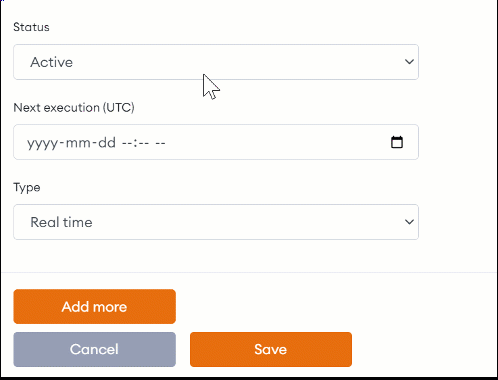Easily Create ServiceNow Workday Integration The Way You Want
Easy to use no-code Servicenow Workday integration and embedded data insights to make things scale further.
- Pre-built configuration-based ServiceNow integration for Workday connector that scales.
- Create multi-step bi-directional Workday to ServiceNow automation to eliminate manual work and improve quality.
- Automate employee onboarding, training, asset management, and team management.
Common Automation Scenarios for Workday and ServiceNow

- Efficiency improvement by automating manual processes such as employee onboarding
- Employee self-service portal request automation for things like benefits information, enrollment, or vacation requests
- Manager one-time or special payment requests for employees
- Equipment provisioning and change of role status
- Training request and completion synchronization
- Centralized employee reporting
- A manager requests a job change
- Benefits and compensation change requests
- Employee offboarding and status change
Many people struggle with ServiceNow integration because of its robust API. Use a visual, drag-and-drop interface to quickly create a practical ServiceNow integration with Workday.
-
Complete bi-directional integration that allows data flow in both directions
-
Real-time to bulk integration that meets your process flow needs
-
Improve efficiencies and minimize IT costs with 24/7 support
-
Centrally manage exceptions, notifications, and errors.
-
Integrated data security and governance


Integration Frequency Selection
Choose the frequency you want the ServiceNow integration to run with Workday.
-
Automated integrations can run at the frequency of your choice and in parallel to each other
-
Bi-directional integrations can run at different speeds
-
Schedule an integration to run sometime in the future or also start in the past to catch up on data after a change.
Create End-to-End Process Automation Steps
Go beyond ServiceNow Workday integration by creating automation processes and workflows that work how you want them to.
-
Efficiently orchestrate multi-step automation that streamlines various operations across Workday and ServiceNow processes.
-
Trigger events, notifications, and actions within Workday and ServiceNow
-
Scale process automation with AI-powered decision-making with intelligence embedded directly into the step functions

This software is designed for the professional to unlock value and can't wait for someone to write code with legacy tools.
Key ServiceNow Workday Integration Solution Capabilities

Bi-Directional Process Flows

Centralize Reporting in Workday or ServiceNow

Discover Business Practice Process Mining

Business Rules and Triggers

No Code Configuration and Custom Data Support

Certified Connectors for 3rd Party

Easy Data Transformations

In-flight Governance
Put It Forward ServiceNow Workday Integration Resources
ServiceNow Workday Integration Infosheet
This Workday ServiceNow integration infosheet shows the high-value outcomes, key features, and solution information.
Case Study
The failed and stalled project turned around with Put It Forward Integration Designer, which reduced overall costs, completed the project, and exceeded the original mandate.
Process Automation vs Orchestration
With increasing workloads across the organization, this discussion walks you through the right time to use process automation or an orchestration solution for ServiceNow Workday integration.
Ready to Take the Next Step Workday ServiceNow Integration?
FAQ about ServiceNow Workday Integration
Bi-directional ServiceNow Workday Integration is the synchronization of processes across the two different datasets and systems. This allows them to act in continuity with one another while maintaining their distinct processes within their respective system.
Bi-directional Servicenow Workday integration allows you to sync tasks, events, data objects and processes between Workday and ServiceNow such as HR onboarding, finance, desktop provisioning, orders and custom data or objects. This provides a great advantage in keeping your workflow running smoothly.
Workday integation with Servicenow by Put It Forward makes it quick to adjust the fields to sync, how they map, and conditions for when to trigger the synchronization process.
Servicenow Workday integration allows you to do a data load, synchronize across systems, export, add data quality checks or govern your data. There are three easy steps to start with it:
1. Point the pre-built connectors from Put it Forward or use your own connector to automatically integrate the source and destination.
2. Click on the data services or add any business rules or transformations to the integration.
3. Get the data flowing between the source and destination by selecting the integration interval and activating it.
Custom objects and data elements are supported via the Put It Forward Integration Designer. As long as the data is exposed via the api it can be integrated through Put It Forward. This includes events, triggers, data elements and custom business logic as well.
Here are common scenarios you would need Workday ServiceNow Integration for:
- Bi-directional HR specific process flows such as onboarding, commissions and PTO tracking.
- Get activity and performance roll up reporting.
- Automate key processes such as employee onboarding, hardware provisioning and change of access.
- Workflow and process improvement to eliminate manual or duplicate functions in each system.
- Integrated reporting and centralized analytics in each system and track time, costs and revenue associated with sales opportunities.
- Reduce the cost of integration and effort to implement a custom integration solution without having to write code.
- Reduce maintenance costs with connectors that are up to date and self documented process flows.
This integration provides business rule-based sync of data. Business rules are guidelines or restrictions about business behavior. For example, Servicenow Workday integration empowers users to decide which events will trigger which actions and which data should be flowing between these two systems. This solution allows you to use business logic without developer assistance and without a need for an additional tool.
Workday ServiceNow integration frequency is a feature that enables users to decide how often data updates. Users can invoke data sync in real-time, just in time event triggers, or in batch cycles.
ServiceNow Workday integration helps you reduce duplication of license costs in each system, save time on manual data updating, increases data quality and reduces the time and expense burden of specialized IT resources.
If you're looking for more information on Servicenow integration you can refer to the ServiceNow integration solution page.